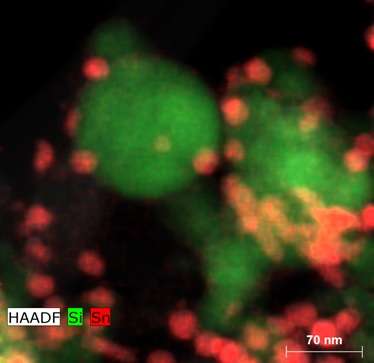Next generation anode to improve lithium-ion batteries

Researchers at the University of California, Riverside have created a new silicon-tin nanocomposite anode that could lead to lithium-ion batteries that can be charged and discharged more times before they reach the end of their useful lives. The longer-lasting batteries could be used in everything from handheld electronic devices to electric vehicles.
Titled "Tin Nanoparticles as an Effective Conductive Addition in Silicon Anodes," a paper describing the research was published Wednesday (Aug. 3) in the journal Scientific Reports. The project was led by Lorenzo Mangolini, an associate professor of mechanical engineering and materials science and engineering in UCR's Bourns College of Engineering.
Lithium-ion batteries, the most popular rechargeable batteries in personal electronics, are composed of three main parts: an anode, a cathode, and a lithium salt dissolved in an organic solvent. While graphite is the material of choice for most anodes, its performance is a limiting factor in making better batteries and expanding their applications.
Both silicon and tin have been investigated as novel high-performance alternatives for graphite anodes. In the current research, Mangolini's group showed for the first time that combining both materials into a single composite leads to dramatic improvements in battery performance. In addition to tripling the charge capacity offered by graphite, the silicon-tin nanocomposite is extremely stable over many charge-discharge cycles, essentially extending its useful life. These features, coupled with a simple manufacturing process, could help the expansion of lithium-ion batteries for use in next-generation vehicles.
"Lithium-ion batteries are growing in popularity for electric vehicles and aerospace applications, but there is a clear need to alleviate range anxiety—the fear that a vehicle won't have enough charge to reach its destination—before we will see large-scale adoption. Any technology that can help is welcome, as long as it is simple and scalable, and our technology meets both those criteria," Mangolini said.
Mangolini said adding tin to the silicon, rather than another conductive material such as carbon black, would circumvent the low conductivity of silicon without decreasing energy storage.
"The synergistic effects between these two materials lead to batteries that exceed the performance of each of the two components alone, an improvement that is a result of the high electrical conductivity and good energy storage capacity of tin. This can be achieved with the addition of even minor amounts of tin, as small as 2 percent by weight," he said.
More information: L. Zhong et al, Tin nanoparticles as an effective conductive additive in silicon anodes, Scientific Reports (2016). DOI: 10.1038/srep30952















